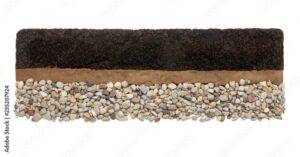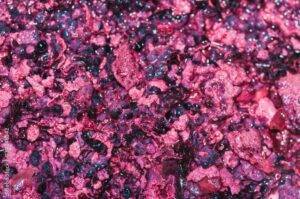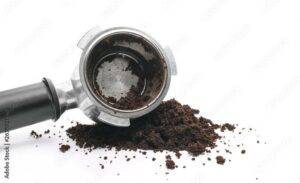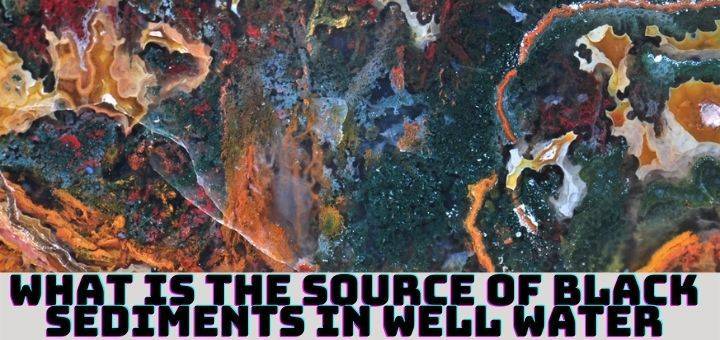If you have been noticing black sediments in your well water, it is important to determine the source of this contamination.
These sediments can be harmful to your health and can also affect the overall quality of your water.
In this post, we will explore the various sources of black sediments in well water and what you can do to address this issue.
By understanding the root cause of the contamination, you can take the necessary steps to improve the quality of your water and protect your health.
In the United States, a manganese concentration of 50 ug/l is considered sufficient. According to the Environmental Protection Agency (EPA), keeping manganese levels at 50 ug/l prevents discoloration of home faucets.
So, if you are concerned about black sediments in your well water, read on to learn more about this issue and how you can solve it.
What is the source of black sediments in well water?

The source of black sediments in well water can vary, but some common causes include:
- Iron:
Iron is a naturally occurring element that is often present in well water. When the water comes into contact with oxygen, it can cause iron to rust and form reddish-brown or black sediments.
- Manganese:
Similar to iron, manganese is a naturally occurring element that can be found in well water. When it comes into contact with oxygen, it can also rust and form black sediments.
- Silt:
Silt is a type of fine-grained soil that can find its way into well water through cracks in the well casing or from nearby construction. Silt can also appear black in color.
- Organic matter:
Organic matter, such as leaves and debris, can also contribute to black sediments in well water. As the organic matter decomposes, it can release tannins and other substances that can discolor the water.
- Bacteria:
Bacterial growth can also cause black sediments in well water. This can occur if the well water has a high bacterial count or if the water is not treated properly.
This may require testing the water to determine the presence of iron, manganese, or other contaminants. Once the source has been identified, you can implement appropriate treatment methods to remove the sediments and improve the quality of your well water.
This may include the use of water filters, chemical treatment, or other methods. It is also important to regularly maintain your well to prevent further contamination and ensure that the water is safe for consumption.
Mineral deposits, on the other hand, can be naturally deposited in water aquifers. This happens when the aquifer’s walls collapse into the water.
The sediments could appear as rust in the water.

Flooding can also cause sediments to be deposited in subsurface water. Although most minerals are filtered away, some will find their way into your water supply, especially if the filters fail.
As a result, the presence of silt in the water usually signals a problem with the good pump. The health consequences of manganese exposure
If you ever wish to eliminate these minerals from your water, I’m guessing your motivations aren’t as strong as they are for aesthetics.
Manganese poisoning can cause nervous system failure, resulting in a disorder that resembles Parkinson’s.
Despite their function in the body, many people may prefer not to ingest them at all, particularly when drinking water, because the metallic taste of water is unpleasant to humans.
While some sediments are hazardous to one’s health, the majority of sediments are only a nuisance. Diseases are caused by sediments containing disease-causing microbes such as bacteria and viruses.
If sediments are accompanied by an unpleasant odor, you should have your water analyzed for pollutants, according to the EPA.
Although only in small levels, iron and manganese are essential for the development of the human organism. These minerals belong to the trace mineral subgroup of vital minerals.
Sand in the water, on the other hand, could indicate that the well is plugged in or that the pump is overworked. Sand in the water might also be caused by a pump that is too deep in the well. Moving an inappropriately positioned pump to the well’s surface is a straightforward solution.
Sediment, Filters for Well Water
Is your water tasting bad or stinking up your home?
The problem may be an accumulation of mineral deposits that are calling for attention. These clumps are called sediments, and depending on the source, they can be the source of noxious odors, bad taste, or just plain watery mess.
If you have noticed sediments in your drinking water, it is best to have them tested by a professional to ensure there are no dangerous contaminants. To ensure that any potential issues are avoided, it is advisable to install a whole-house water filter system. Once installed, the system will remove sediment buildup through all of your plumbing for a safe and clean supply.
Once you have determined that your water is safe, then you are ready to begin removing the minerals that are causing the issues with your water. If your pipes are well maintained, then moving your water source can also help clean things up. The key here is to make sure to only move the water source if it is safe to do so.
What is the most efficient way to get rid of all black sediments in water?
The oxidation and filtration processes, or a combination of the two. This is the situation because soluble solids cannot be filtered and insoluble solids cannot be oxidized. When both procedures are used simultaneously, the filtered water quality improves.
What should you do if your well water contains black sediments?
Has your water tested if the sediments are accompanied by an unpleasant odor or a terrible taste?
Installing a water filtering system throughout the house
Replacement of pipes
Changing the location of the pump
Is it possible to rely solely on certified accredited lab testing, or are there other options?
The best solution should be accredited laboratory tests. Water testing, on the other hand, goes much further. You could choose to get a test kit and follow the procedures of the sediment removal technique step by step at home.
How to remove sand in well water

It sounds simple enough but often there is something else in the water that needs to be removed. Sometimes it is the sand in the water itself or even foreign objects such as mud. Whatever it is it can stop the pump from working effectively and this can cause the water quality to deteriorate.
If you keep finding sand in your well water, there are a few things that you can do to remove it and get the pump working again.
If you want to remove sand from your water, you can purchase a sand separator, which is typically installed between the pump and the pressure tank on the ground. The water is spun by this device, causing sand to settle at the bottom and water to enter the pressure tank.
If your well water contains black sediment, what should you do?
Water testing is required to determine the level of contaminants in the drinking water if there is black sediment in the water, as well as a bad taste and an unpleasant odor.
Iron, silica, bacteria, hardness, and manganese should all be tested in well water, in our opinion. You can also go to your local health department’s or the State Department’s website to get a certified lab inspection.
If you pull water from your tap and find dark brown rocks or sand particles. It’s possible that your good pump is below the established standard, which is a minimum of fifteen to twenty feet above the well’s bottom.
You can resolve this issue by raising the pump shaft and increasing the distance between it and the well base.
The wall box could be another source of black sediment in well water. The housing is made of doubled PVC plastic and is installed inside the good wall to keep mud and sand out while allowing water to flow in.
Over time, silt and sand settle and enter the well through the enclosure display gadgets. It’s a good idea to get confirmation from a well-driller.
Problems with bacteria in well water
Bacteria are ubiquitous in nature and, for the most part, harmless. Bacteria found in the human digestive system, for example, play an important role in digestion.
Bacteria in well water, on the other hand, usually indicate that the water is contaminated with pathogenic microbes.
The presence of bacteria in most cases indicates that human waste has infiltrated the well. Sewage or human waste enters underground water when a sewer system leaks, eventually reaching rivers and underground water.
You should boil your well water before drinking it if it contains bacteria.
Furthermore, adding chlorine to well water before drinking it can effectively treat it. Investing in a home chlorination system makes it simple to add chlorine to your water.
What causes dark brown in well water?
These minerals have been discovered in wells and springs in Pennsylvania. Higher iron levels were found in 18% of the private water supply sources analyzed across Pennsylvania, according to a Penn State study.
In deep wells, where water has been in touch with rock for an extended period of time, natural manganese and iron sources are more abundant. Underground and surface mining activities can both result in black sediment in your water.
The majority of these minerals are found in the United States’ northern and western regions.
Filters for Sediments of the Highest Quality
If your water contains a lot of sediments, you should install a sediment filter. Sediment filters have the advantage of being both effective and affordable. Review of well water sediment filters
Filters for oxidation

This is a slight improvement over utilizing polyphosphate. Before screening iron and manganese, oxidizing filters oxidize them.
Greenland that has been manganese-treated, as well as other materials like Birm, are used to construct the filter.
In a green manganese filter, the filter medium is coated with potassium permanganate, which oxidizes the reduced iron and manganese and then filters them out of the water.
To eliminate rusted iron and manganese particles, these devices must be backwashed on a regular basis. Furthermore, the potassium permanganate solution used for regeneration is extremely dangerous and must be handled with extreme attention and kept in accordance with all safety procedures.
When properly maintained, manganese green filters are usually effective for moderate amounts of dissolved and oxidized manganese and iron.
The frequency of reverse washing and regeneration increases with increasing metal concentrations. Remember that these filters are only recommended when the iron and manganese concentrations are between 3 and 10 mg/L.
Even under optimum conditions, birm filter manganese removal performance varies. Backwashing birm filters is critical for removing accumulated oxidized metal particles.
Fourth, this method of processing is quite similar to that of oxidizing filters. It is excellent for manganese and iron removal because it uses both oxidation and filtration processes.
Why Do I Need a Black Sediment Filter?
It’s safer than drinking tap water. By removing impurities and sediments, the sediment filter allows you to get the most out of your water. They have been approved by the FDA’s regulatory board and are extremely competent in their field. It is less dangerous than bottled water.
Despite the fact that it is clean water, the bottled water market is small. The FDA’s regulatory council is powerless to set severe requirements, guaranteeing that your tap water is as safe as bottled water.
Water is cleaned of large sediments and bacteria. Particle filters are used to remove silt of any size. The materials used for elimination make the job easier.
Eco-friendly: The sediment filter reduces the need to buy bottled water. This will reduce plastic waste in the environment by lowering the use of plastic bottles.
It refers to the water bottle that you may need to acquire from time to time. The sediment filter eliminates the need to buy a water bottle because clean water will be readily available at no additional cost.
Conclusion
The black sediments in the well water indicate the presence of manganese. While manganese is normally present in small amounts in water, when it accumulates, it appears as black sediments. Minerals like manganese, iron, calcium, and others can naturally accumulate in aquifers.
If the black particles are accompanied by dangerous microbes, the water should be checked. Check to ensure that your pump is correctly positioned. Manganese is found in minute amounts across the world, and water levels are rising.
Other minerals such as iron and calcium, as well as these, can be deposited in the aquifer. Because well water is generated from the soil, bacteria, lead, arsenic, chromium-6, mercury, manganese, radon, and other volatile organic compounds (VOCs) are likely to be present. It goes without saying that eliminating pollutants from well water necessitates the use of a sedimentation filter.
Related post:
- 23 Must Try Outdoor Fire Pit Setups for Cozy Nights - July 5, 2025
- 24 Modern Fire Pit Ideas to Elevate Your Backyard Style - July 5, 2025
- 15 Unique DIY Fire Pit Ideas That Instantly Upgrade Your Backyard - July 4, 2025

